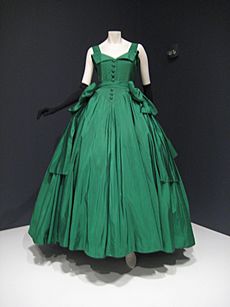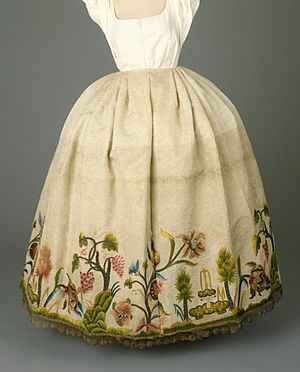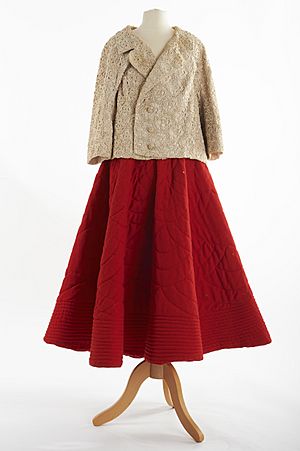Petticoat facts for kids

A petticoat is a woman's undergarment, shaped like a skirt or skirt+bodice. Think of it as a skirt underneath a regular skirt. The purpose is possibly insulation, and certainly to make the skirt fly out in an attractive way.
Petticoats which are starched, with ruffles, or made with stiff fabric, can support a wider skirt. The ultimate in this trend is the crinoline, which is a petticoat structure which includes hoops of whalebone. Crinolines are not worn today, but petticoats are sometimes worn with ballgowns.
Terminology
Sometimes a petticoat may be called a waist slip or underskirt (UK) or half slip (US), with petticoat restricted to extremely full garments. A chemise hangs from the shoulders. Petticoat can also refer to a full-length slip in the UK, although this usage is somewhat old-fashioned.
History
In the 14th century, both men and women wore undercoats called "petticotes". The word "petticoat" came from Middle English pety cote or pety coote, meaning "a small coat/cote". Petticoat is also sometimes spelled "petty coat". The original petticoat was meant to be seen and was worn with an open gown. The practice of wearing petticoats as undergarments was well established in England by 1585. In French, petticoats were called jupe. The basquina, worn in Spain, was considered a type of petticoat.
The petticoat in western men’s dress, what would become known in later years develop into the waistcoat, was from the mid-15th century to around the 17th century an under-doublet. The garment was worn in cooler months under a shirt for warmth, and was usually padded or quilted.
In the 18th century in Europe and in America, petticoats were an integral component of a gown, considered a part of the exterior garment and were meant to be seen. The term petticoat was used to refer to such an outer skirt from the 16th to the 19th century, which were fashioned from either matching or contrasting textiles, in simple fabrics, or were highly decoratively embroidered. An underpetticoat was considered an undergarment and was shorter than a regular petticoat. Underpetticoats were also known as a dickey. Also in the American colonies, working women wore shortgowns (bedgowns) over petticoats that normally matched in color. The hem length of a petticoat in the 18th century depended on what was fashionable in dress at the time. Often, petticoats had slits or holes for women to reach pockets inside. Petticoats were worn by all classes of women throughout the 18th century. The style known as polonaise revealed much of the petticoat intentionally.
In the early 19th century, dresses became narrower and simpler with much less lingerie, including "invisible petticoats". Then, as the waltz became popular in the 1820s, full-skirted gowns with petticoats were revived in Europe and the United States.
In the Victorian era, petticoats were cemented as undergarments, used to give bulk and shape to the skirts worn over the petticoat. By the mid 19th century, petticoats were worn over hoops also known as crinoline. Popular white cotton petticoats as an undergarment in this 1860s, for example, regularly featured a lace and broderie anglaise decorative border. As the bustle became popular in the 1870s, petticoats developed flounces towards the back in order to cater for this style of under structure. Petticoats also continued to be worn in layers through this decade. Coloured petticoats came into fashion by the 1890s, with many being made from silk and featuring decorative frills to the bottom edge.
Petticoats in the 20th century
For most of the first half of the 20th century, with a few exceptions, petticoats were out of fashion. Certainly multiple petticoats were not needed for the narrow skirts and dresses which were fashionable. Some evening gowns needed petticoats, but they were finished off by WWII wartime rationing and shortages.
Petticoats were revived by Christian Dior in his full-skirted New Look of 1947. Tiered, ruffled, stiffened petticoats remained extremely popular during the 1950s, especially with teenage girls. Typically, at least three single petticoats were worn, until manufacturers began making double and triple layer petticoats. A narrow slip was usually worn under the petticoats, especially the crinoline type, because they tended to be 'scratchy'.
Dior continued this theme with his A-Line collection of Spring 1955, which featured the "most wanted silhouette in Paris". This was a "fingertip-length flared jacket worn over a dress with a very full, pleated skirt". Evening dresses at this time were always worn with petticoats.
Although an A-shape, this silhouette was not identical to what is now understood to embody the A-line idea. That idea was given its definitive expression and popularized by Dior’s successor, Yves Saint Laurent, with his Trapeze Line of Spring 1958, which featured dresses flaring out dramatically from a fitted shoulder line. A-line clothes remained popular in the 1960s and 70s.
Images for kids
See also
 In Spanish: Tontillo para niños
In Spanish: Tontillo para niños




